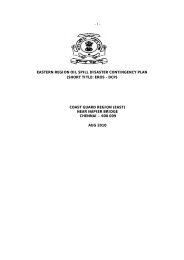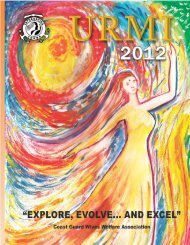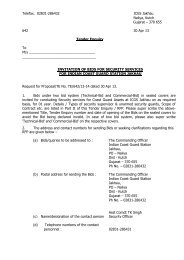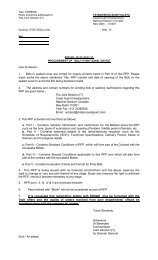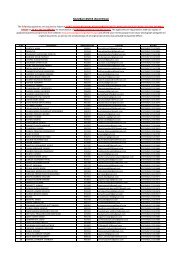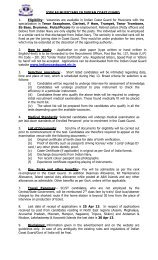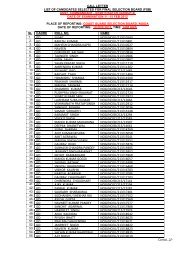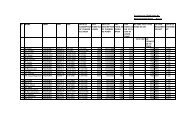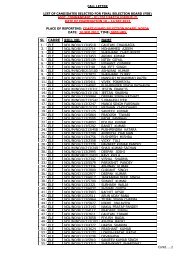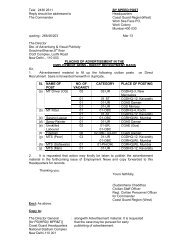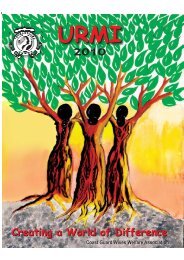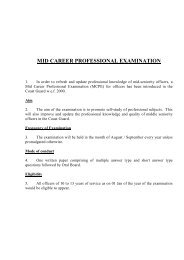Environment Risk Analysis - Indian Coast Guard
Environment Risk Analysis - Indian Coast Guard
Environment Risk Analysis - Indian Coast Guard
You also want an ePaper? Increase the reach of your titles
YUMPU automatically turns print PDFs into web optimized ePapers that Google loves.
THE TENTH NATIONAL OIL SPILL DISASTER CONTINGENCY PLAN MEETING<br />
(NOS-DCP) SEP 2007<br />
OIL SPILLS RISK ANALYSIS:<br />
AN OVERVIEW<br />
Manju Mohan,<br />
Centre for Atmospheric Sciences,<br />
<strong>Indian</strong> Institute of Technology,<br />
Hauz Khas, New Delhi, India<br />
mmohan6@hotmail.com<br />
10 th NOS-DCP Meeting<br />
1<br />
Prof. Manju Mohan<br />
CAS, IIT Delhi
INTRODUCTION<br />
• Oil Spill: Release of large amount of oil into a water<br />
body leading to disastrous environmental effects.<br />
• Oil spills can occur due to various reasons such as<br />
– Equipment breakdown in an oil tanker which causes<br />
leakage of oil into the sea<br />
– When countries are at war, one country may decide<br />
to dump gallons of oil into the other country’s<br />
oceans.<br />
– Illegal dumping of crude and waste oil into ocean<br />
– Natural disasters (like hurricanes) may cause an oil<br />
spill, too by causing an oil tanker to flip over,<br />
pouring oil out.<br />
10 th NOS-DCP Meeting<br />
2<br />
Prof. Manju Mohan<br />
CAS, IIT Delhi
MAJOR OIL SPILL INCIDENTS<br />
Year Place Tanker spill (in tons)<br />
1983 The Persian Gulf Nowruz Oil<br />
Field<br />
1983 South Africa Castillo De<br />
Belluer<br />
100,000<br />
160,000<br />
1988 The Monongahela<br />
River<br />
1989 Prince William<br />
Sound, Alaska<br />
1993 Off The Shetland<br />
Islands<br />
Storage Tank 2,400<br />
Exxon Valdez 37,620<br />
Braer 85,000<br />
1996 Off SW Wales Sea Empress 72, 000<br />
2001 Galapagos Islands Jessica 600<br />
10 th NOS-DCP Meeting<br />
3<br />
Prof. Manju Mohan<br />
CAS, IIT Delhi
RISK ANALYSIS:<br />
GENERAL OVERVIEW<br />
10 th NOS-DCP Meeting<br />
4<br />
Prof. Manju Mohan<br />
CAS, IIT Delhi
Stages of <strong>Risk</strong> <strong>Analysis</strong><br />
Hazard Identification<br />
Frequency <strong>Analysis</strong><br />
Consequence <strong>Analysis</strong><br />
<strong>Risk</strong> Calculation<br />
10 th NOS-DCP Meeting<br />
5<br />
Prof. Manju Mohan<br />
CAS, IIT Delhi
1. Hazard Identification: Identification and generation of a<br />
comprehensive and representative set of events which can<br />
realistically cause a spill. Diagrammatically, this can be<br />
represented by a spill event tree etc. Usually these events<br />
are<br />
• Collision: the striking together of two vessels whilst underway;<br />
• Grounding: a vessel touches the sea bottom, either powered or<br />
drifting;<br />
• Contact: a vessel strikes an external object other than another<br />
vessel or sea bottom;<br />
• Cargo transfer failure: a cargo spill occurs while conducting<br />
ship/shore or ship/ship loading or unloading;<br />
• Fire/explosion: occurs onboard vessel but not due to above;<br />
• Structural failure: the hull cracks;<br />
• Sinking: a vessel sinks due to breach in watertight integrity or<br />
adverse loading.<br />
10 th NOS-DCP Meeting<br />
6<br />
Prof. Manju Mohan<br />
CAS, IIT Delhi
2. Frequency <strong>Analysis</strong> i.e. Assessment of oil release<br />
probability. Mostly, this is estimated by combination of<br />
component probabilities derived on basis of reliability<br />
data (if available) and statistical analysis of historical<br />
data. Other sources of frequency analysis are<br />
– Data and Statistics<br />
– Expert Advice<br />
– Historical Records<br />
– Ground Truthing<br />
– Consultation<br />
– Individual Experience<br />
10 th NOS-DCP Meeting<br />
7<br />
Prof. Manju Mohan<br />
CAS, IIT Delhi
3. Consequence <strong>Analysis</strong>: The effects of oil spill are<br />
analysed in terms of following scenarios<br />
– <strong>Environment</strong>al<br />
– Ecological<br />
– Habitat<br />
– Fisheries<br />
– Tourism<br />
– Aquaculture<br />
– Cultural<br />
– Economic<br />
• The analysis of oil spills requires evaluation of spill size<br />
distribution. The basic approach to spill size estimation<br />
is through the use of log normal distribution<br />
assumption<br />
10 th NOS-DCP Meeting<br />
8<br />
Prof. Manju Mohan<br />
CAS, IIT Delhi
4. <strong>Risk</strong> Calculation: Broadly risk can be represented as<br />
– Probability of occurrence and exposure expressed as a<br />
percent chance<br />
– <strong>Risk</strong> Units which quantify both the occurrence of oil spill<br />
and consequence associated with it.<br />
• Quantification of spill consequences involves<br />
determination of spread and evaporation of oil slick,<br />
interaction with rough seas and their eventual break<br />
up followed by determination of trajectory of oil slicks<br />
and probable shoreline impact.<br />
<br />
the quantified results are displayed in terms of risk<br />
profiles viz., event or fault tree or Hazard Maps or<br />
Graphs depicting percent chance of exposure or <strong>Risk</strong><br />
Units.<br />
10 th NOS-DCP Meeting<br />
9<br />
Prof. Manju Mohan<br />
CAS, IIT Delhi
Determination of Spread of Oil Spill<br />
Spill <strong>Analysis</strong> Models<br />
Statistical <strong>Analysis</strong> of<br />
Past Incidents<br />
Modeling of oil spills<br />
(trajectory<br />
simulation)<br />
Statistical analysis is<br />
is feasible if extensive<br />
useful in absence of<br />
information of<br />
requisite model inputs.<br />
variables such as<br />
Oil spill estimation is<br />
meteorology, marine<br />
based on previous<br />
currents, oil chemistry,<br />
incidents<br />
ship structure etc are<br />
available.<br />
10 th NOS-DCP Meeting<br />
10<br />
Prof. Manju Mohan<br />
CAS, IIT Delhi
CASE STUDIES<br />
10 th NOS-DCP Meeting<br />
11<br />
Prof. Manju Mohan<br />
CAS, IIT Delhi
Crete, Greece *<br />
METHODOLOGY OVERVIEW<br />
• Hazard identification: oil pollution caused by heavy<br />
marine traffic and ship wreckage<br />
• Frequency <strong>Analysis</strong>: based on available data for oil spill<br />
incidents in the area of Crete covering the period 1995-<br />
1999<br />
• Consequence <strong>Analysis</strong>: a general relational rating<br />
system of high, medium and low was used to identify<br />
the probability of the threat occurring. Scenarios<br />
covered: tourists, fisheries and environmental<br />
• <strong>Risk</strong> Calculations: Representation in terms of <strong>Risk</strong><br />
Units<br />
* : Kassomenos, 2003<br />
10 th NOS-DCP Meeting<br />
12<br />
Prof. Manju Mohan<br />
CAS, IIT Delhi
Background of the <strong>Analysis</strong><br />
• Crete is one of the majors Mediterranean islands,<br />
located in the South Aegean Sea.<br />
• Crete has about 600000 habitants, but more than 5<br />
million tourists visit the island during an entire year.<br />
• The areas of Cretan Sea are characterized by heavy<br />
marine traffic.<br />
• The frequent navigation of tankers through this area<br />
enhances the possibility of marine pollution by oilbased<br />
waste from the ships as well as from possible<br />
shipwrecks.<br />
10 th NOS-DCP Meeting<br />
13<br />
Prof. Manju Mohan<br />
CAS, IIT Delhi
• Crete consists of 4 prefectures (administrative areas),<br />
specifically from west to the east, prefectures of Hania,<br />
Rethymnon, Ieraklion and Sitia.<br />
• There are 5 significant cities located in the north of<br />
Crete and one in the South.<br />
• The capital Heraklion with about 150000 people,<br />
Chania with about 80000, Rethymnon with about 30000<br />
and Ag. Nikolaos and Sitia.<br />
• The city of Ierapetra is located in the Southeast part of<br />
the island, with about 15000 habitants. The last three<br />
cities are located in the Prefecture of Lasithi.<br />
10 th NOS-DCP Meeting<br />
14<br />
Prof. Manju Mohan<br />
CAS, IIT Delhi
Map of Crete<br />
10 th NOS-DCP Meeting<br />
15<br />
Prof. Manju Mohan<br />
CAS, IIT Delhi
<strong>Risk</strong> <strong>Analysis</strong> Methodology<br />
• Cretan Sea is characterized by winds blowing from the<br />
Northern sector, throughout the year. Southern winds,<br />
that potentially could transport pollutants towards the<br />
area of the southern coast of Crete, represent less than<br />
15% of the days.<br />
• Use of general relational rating system of high, medium<br />
and low to identify the probability of the threat<br />
occurring.<br />
• The planning process should identify and measure the<br />
probability of all potential risks and the impact on the<br />
ecosystem or human/financial activity if that threat<br />
occurred.<br />
10 th NOS-DCP Meeting<br />
16<br />
Prof. Manju Mohan<br />
CAS, IIT Delhi
• As per priorities of significance of a particular threat ,<br />
the impacts were rated as follows:<br />
– 0 = No impact in the financial activity of the<br />
population or no ecological disaster in the protected<br />
areas.<br />
– 1 = Noticeable impact<br />
– 2 = Damage<br />
– 3 = Major damage<br />
• To measure the potential risks, a weighted point rating<br />
system was developed.<br />
• Each level of probability was assigned points as follows:<br />
High risk, points 10, Medium risk, points 5 and Low<br />
risk, one point.<br />
10 th NOS-DCP Meeting<br />
17<br />
Prof. Manju Mohan<br />
CAS, IIT Delhi
• The points assigned to each risk level are introduced in<br />
such a way to separate the three different risk levels,<br />
quantify the risks and discriminate the results.<br />
• To obtain a weighted risk rating, probability points was<br />
multiplied by the highest impact rating for each activity.<br />
• Based on this rating method, threats that pose the<br />
greatest risk (e.g., 15 points and above) can be<br />
identified.<br />
• The following infrastructure, in the region of Crete was<br />
identified as vulnerable to oil-spills:<br />
– Protected areas and locations of special natural beauty<br />
– Zones of Fishing and Pisciculture<br />
– Tourist zones - Tourist Installations and beaches<br />
10 th NOS-DCP Meeting<br />
18<br />
Prof. Manju Mohan<br />
CAS, IIT Delhi
• The combined <strong>Risk</strong> Units for each month and area were<br />
calculated according to the following formula:<br />
– RU : <strong>Risk</strong> Units<br />
RU ij = á i × b j × (c k + d m +e n )<br />
– i month i=1,...,12, j: area (Heraklion, Chania, Sitia,<br />
Agios Nikolaos, Rethymnon, South Crete) j=1,...,5<br />
– a i month factor, a i =1,5,10 ; b j area factor, b j =1,2,3<br />
– c k prevailing wind flow (Northern, Southern) C k =1,2,<br />
k=1,2<br />
– d m Kind of disaster (fishing area, tourist installation,<br />
protected area), d m =1,2,3, m=1,2,3<br />
– e n possibility of early fighting, e n = 1,2,3,4,5, ;<br />
n=1,...,5<br />
10 th NOS-DCP Meeting<br />
19<br />
Prof. Manju Mohan<br />
CAS, IIT Delhi
• When the combined <strong>Risk</strong> Units (RU) are less than 80,<br />
then the risk is considered to be low, when RU is<br />
between 80 and 150 the risk is moderate and for more<br />
than 150 risk units the risk is high.<br />
• This threshold was chosen, for the high risk, because it<br />
represents the beginning of the upper half of the scale.<br />
10 th NOS-DCP Meeting<br />
20<br />
Prof. Manju Mohan<br />
CAS, IIT Delhi
Results from Crete Oil Spill <strong>Risk</strong> <strong>Analysis</strong><br />
• The regions of Chania, and Heraklion present high<br />
risks, increasing during the summer period with<br />
northern winds.<br />
• The area of the Prefecture of Rethymno (Agios Nikolaos<br />
and Sitia ) presents low risk than, nevertheless,<br />
increases during the summer period with northern<br />
winds.<br />
• The areas of Southern Crete presented low risk and<br />
thus seems to be less vulnerable to oil spill risks.<br />
10 th NOS-DCP Meeting<br />
21<br />
Prof. Manju Mohan<br />
CAS, IIT Delhi
<strong>Risk</strong> Combination for Fishing areas and pisciculture installations<br />
in Crete. Numbers are in risk units<br />
10 th NOS-DCP Meeting<br />
22<br />
Prof. Manju Mohan<br />
CAS, IIT Delhi
<strong>Risk</strong> Combination for Tourist zones, and Tourist installations in Crete.<br />
Numbers are in risk units<br />
10 th NOS-DCP Meeting<br />
23<br />
Prof. Manju Mohan<br />
CAS, IIT Delhi
<strong>Risk</strong> Combination for Protected areas and sites of special natural beauty.<br />
Numbers are in risk units<br />
10 th NOS-DCP Meeting<br />
24<br />
Prof. Manju Mohan<br />
CAS, IIT Delhi
METHODOLOGY OVERVIEW<br />
• Hazard identification: activities associated with offshore<br />
oil exploration, production, and transportation resulting<br />
from oil lease sales<br />
Gulf of Mexico (GoM) * Prof. Manju Mohan<br />
• Frequency <strong>Analysis</strong>: deliberately initiated hypothetical<br />
oil spills uniformly in space and time<br />
• Consequence <strong>Analysis</strong>: oil spill trajectory simulations<br />
through the OSRA Model #<br />
• <strong>Risk</strong> Calculations: expressed as percent chance that an<br />
oil spill starting within a particular launch area<br />
contact a segment under study<br />
*:Minerals Management Service, U.S. Department of the Interior, 2007<br />
#: developed by Smith et al. (1982) & enhanced by MMS (LaBelle & Anderson, 1985; Ji et al., 2003-04)<br />
will<br />
10 th NOS-DCP Meeting<br />
25<br />
CAS, IIT Delhi
• The Minerals Management Service (MMS) has<br />
conducted a formal oil-spill risk analysis (OSRA) to<br />
provide spill statistics that can be used in contingency<br />
planning for U.S. Outer Continental Shelf (OCS) lands<br />
in the Gulf of Mexico<br />
• The study area is the Walker Ridge Planning Area that<br />
encompasses a portion of the offshore waters within the<br />
Gulf of Mexico and is approximately 140 to 160 nautical<br />
miles offshore.<br />
• The OSRA Model, simulates oil-spill transport using<br />
realistic data fields of winds and ocean currents in the<br />
GOM.<br />
10 th NOS-DCP Meeting<br />
26<br />
Prof. Manju Mohan<br />
CAS, IIT Delhi
Location of Gulf of<br />
Mexico<br />
Counties/Parishes<br />
(not to scale)<br />
10 th NOS-DCP Meeting<br />
27<br />
Prof. Manju Mohan<br />
CAS, IIT Delhi
Locations of the U.S./Mexico international boundary segments<br />
in the Gulf of Mexico<br />
10 th NOS-DCP Meeting<br />
28<br />
Prof. Manju Mohan<br />
CAS, IIT Delhi
• At about 11 km intervals in the north-south direction<br />
and about 10 km intervals in the east-west direction,<br />
the OSRA model launched a hypothetical oil spill every<br />
1.0 day. At this resolution, there were 15 total launch<br />
points in space, and hypothetical spills were launched<br />
from each spatial grid point over two time periods, 9<br />
years and 7 years.<br />
• The environmental resources considered in this<br />
analysis include the counties and parishes along the<br />
coast of the Gulf of Mexico.<br />
• The hypothetical oil-spill launch area for this analysis is<br />
between 140 and 160 nautical miles from the coast.<br />
10 th NOS-DCP Meeting<br />
29<br />
Prof. Manju Mohan<br />
CAS, IIT Delhi
• The model calculates the movement of hypothetical<br />
spills by successively integrating time sequences of two<br />
spatially gridded input fields: the surface ocean<br />
currents and the sea-level winds, both of which were<br />
generated by other computer models using many<br />
observations of relevant physical parameters. In this<br />
fashion, the OSRA Model generates time sequences of<br />
hypothetical oil-spill locations–essentially, oil-spill<br />
trajectories.<br />
• At each successive time step, the OSRA Model<br />
compares the location of the hypothetical spills against<br />
the geographic boundaries of shoreline and designated<br />
offshore environmental resources.<br />
10 th NOS-DCP Meeting<br />
30<br />
Prof. Manju Mohan<br />
CAS, IIT Delhi
• The model counts the occurrences of oil-spill contact to<br />
these areas during the time periods that the habitat is<br />
known to be used by the resource.<br />
• Finally, the count of occurrence of oil spill contact is<br />
used to compute frequencies and consequently<br />
probabilities of oil-spill contact for designated oil-spill<br />
travel times (e.g., 3, 10, or 30 days).<br />
10 th NOS-DCP Meeting<br />
31<br />
Prof. Manju Mohan<br />
CAS, IIT Delhi
• Two separate model runs were used to calculate the<br />
trajectories for this statistical report.<br />
– 9-year (1986-1994) simulation performed by<br />
Dynalysis of Princeton (Herring, et al., 1999)<br />
– 7-year period, 1993-1999, performed by Princeton<br />
University (Oey, et al.,2004) for and the results were<br />
saved at 1-hour intervals.<br />
• The statistics for the contacts by the trajectories forced<br />
by the two model runs were combined for the average<br />
probabilities.<br />
• The ocean model simulations were extensively skillassessed<br />
with many observations from the GoM<br />
(Herring et al., 1999; Oey, et al., 2005) and a good<br />
determination of the model’s veracity was made.<br />
10 th NOS-DCP Meeting<br />
32<br />
Prof. Manju Mohan<br />
CAS, IIT Delhi
Results from GoM Oil Spill <strong>Risk</strong> <strong>Analysis</strong><br />
• As one might expect, the environmental resource<br />
locations closest to the spill sites had the greatest risk<br />
of contact.<br />
• Due to the climatology of the wind, the spring season<br />
had the higher average probabilities of contact (the<br />
highest being 8 percent), and the fall season had the<br />
lowest (none greater than 0.5 percent).<br />
• With increased travel time, the complex patterns of<br />
wind and ocean currents produce eddy-like motions of<br />
the oil spills and multiple opportunities for a spill to<br />
make contact with any given environmental resource.<br />
10 th NOS-DCP Meeting<br />
33<br />
Prof. Manju Mohan<br />
CAS, IIT Delhi
10 th NOS-DCP Meeting<br />
34<br />
Prof. Manju Mohan<br />
CAS, IIT Delhi
10 th NOS-DCP Meeting<br />
35<br />
Prof. Manju Mohan<br />
CAS, IIT Delhi
Remote Sensing & GIS :Tool in <strong>Risk</strong> Assessment*<br />
• Provide a real time and low cost system for detecting oil<br />
spill, and assess spillage risk.<br />
• The System is made of three sub-systems, that is, (i)<br />
Detection and Monitoring, (ii) spatial database, and (iii)<br />
Prediction.<br />
• Oil spill data, access and protection information will be<br />
placed in GIS database and interfacing it with a<br />
relational database for rapid access, retrieval and<br />
query.<br />
*: Shattri B: Remote Sensing and GIS Application In Oil Spills <strong>Risk</strong> Assessment, GIS Development.net,1998<br />
10 th NOS-DCP Meeting<br />
36<br />
Prof. Manju Mohan<br />
CAS, IIT Delhi
• The remotely sensed data as spatial data input is used<br />
to derive valuable information about marine water<br />
pollution, especially on oil spillage.<br />
• The remotely sensed data including LANDSAT TM,<br />
SPOT Panchromatic and MSS (Multi Spectra Scanner),<br />
and air-borne images are integrated in the GIS based oil<br />
spill risk management system in order to detect, assess<br />
the risk and handle the oil spills problem in an alert<br />
situation.<br />
10 th NOS-DCP Meeting<br />
37<br />
Prof. Manju Mohan<br />
CAS, IIT Delhi
• Various information can be retrieved from this system<br />
such as location of oil spills, quantity of oil spills, their<br />
distribution in the affected area; for example location of<br />
the areas of heaviest contamination, the length of<br />
shoreline affected by the oil slick.<br />
• An oil slick movement model incorporated into this<br />
system in favor of predicting the oil slick movement<br />
direction and duration to reach the shoreline. Wind,<br />
wave and current are the main parameters for this<br />
model.<br />
10 th NOS-DCP Meeting<br />
38<br />
Prof. Manju Mohan<br />
CAS, IIT Delhi
• The GIS based system can be used to establish the<br />
appropriate response and locate the dense areas in a<br />
slick and local surveillance, to permit clean-up vessels<br />
to detect the oil to be cleared in rapid circumstances.<br />
• This risk management system will allow new<br />
opportunities for assessment, multiple resource<br />
planning, permit viewing of the state's natural<br />
resources in ways out therefore realized, improve the<br />
decision-making process, and provide a baseline for<br />
future assessments.<br />
10 th NOS-DCP Meeting<br />
39<br />
Prof. Manju Mohan<br />
CAS, IIT Delhi
CALM<br />
WATER<br />
TANKER<br />
OIL RELEASED<br />
BY TANKER<br />
Satellite Imaging of an Oil Spill by a Tanker<br />
Image Source: Optical Society of America, 2002<br />
10 th NOS-DCP Meeting<br />
40<br />
Prof. Manju Mohan<br />
CAS, IIT Delhi
CONCLUSIONS<br />
• A schematic risk assessment is required for proper<br />
analysis of threat of oil spills in marine environments.<br />
• Both past data and model results can be used for risk<br />
estimation and are used as per background conditions<br />
for various regions.<br />
• <strong>Risk</strong> analysis can be carried out in different ways but<br />
should achieve the ultimate objective of threat<br />
representation so that prevention strategies can be<br />
formulated.<br />
10 th NOS-DCP Meeting<br />
41<br />
Prof. Manju Mohan<br />
CAS, IIT Delhi
10 th NOS-DCP Meeting<br />
42<br />
Prof. Manju Mohan<br />
CAS, IIT Delhi



